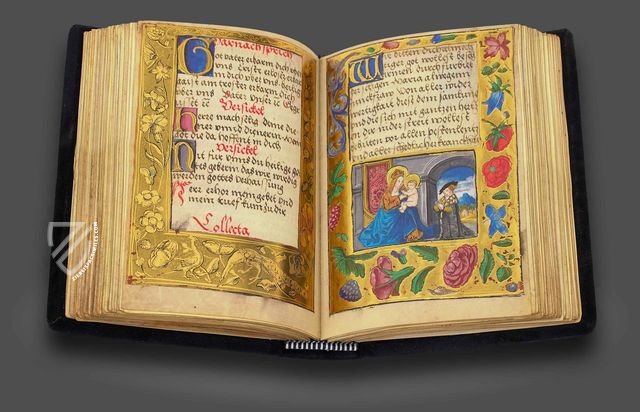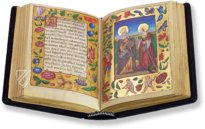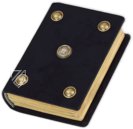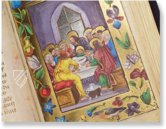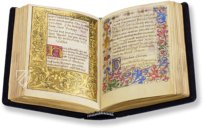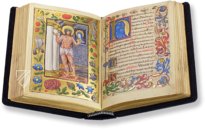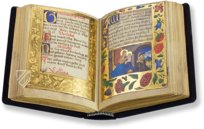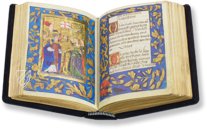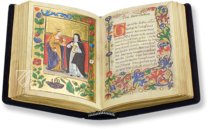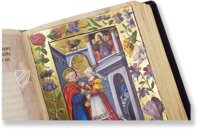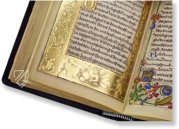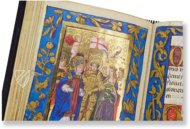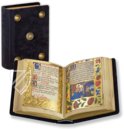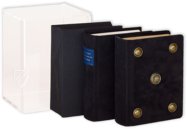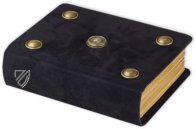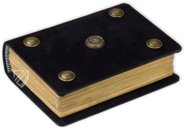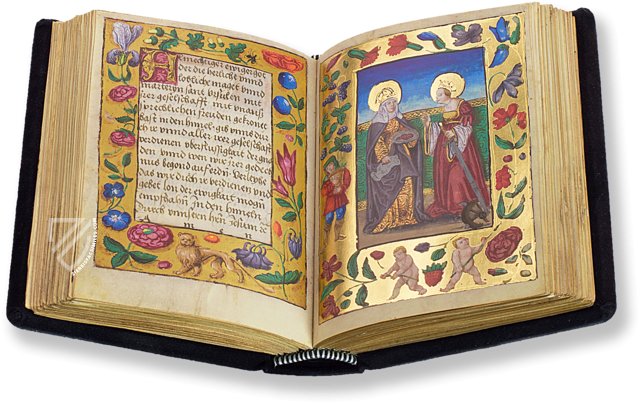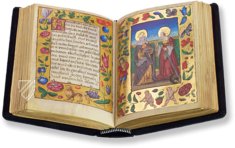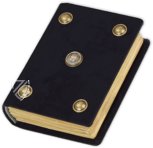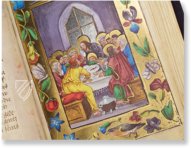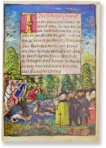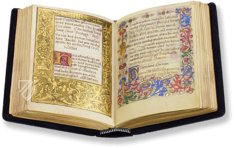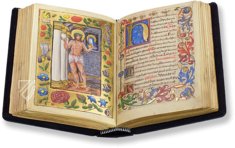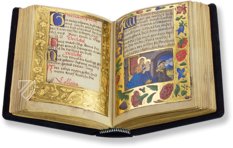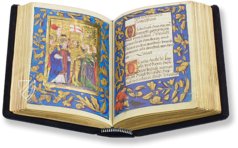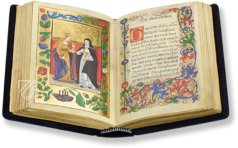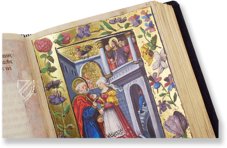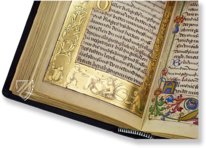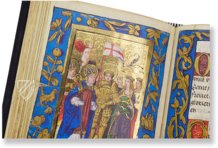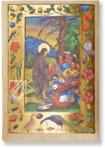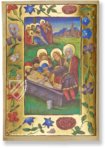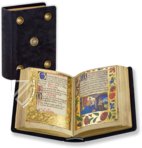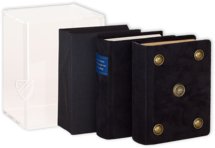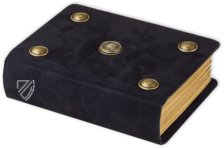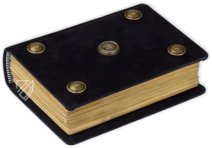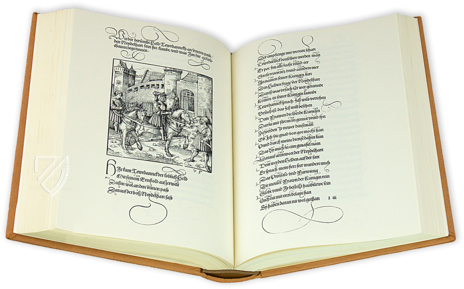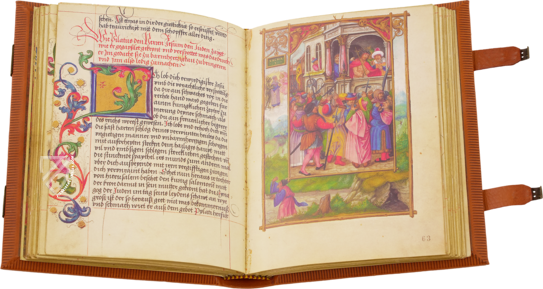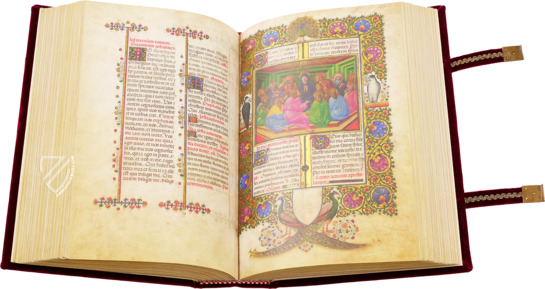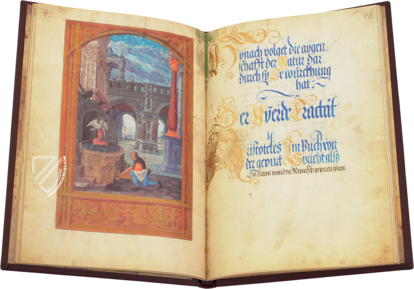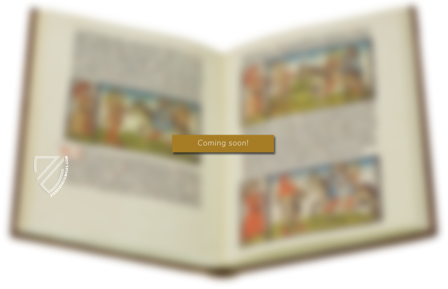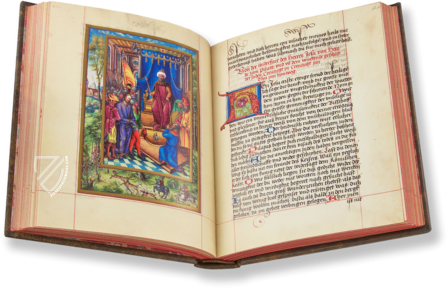German Prayer Book of the Margravine of Brandenburg
(1,000€ - 3,000€)
One of the most beautiful and splendidly furnished manuscripts of German book art was made: the German Prayer Book of the Margravine of Brandenburg. The work was completed in 1520 for the occasion of Susanna of Bavaria’s wedding to Casimir, Margrave of Brandenburg-Ansbach and was decorated in strict accordance with her wishes. 47 large-format, impressive miniatures illustrate the text and 214 pages of the manuscript feature frames inspired by Flemish, Italian and German examples. This splendid combination of artistic influences was an early triumph by an Augsburg illuminator named Narziß Renner, who was only 18 years old at the time. Throughout the manuscript, there are hidden indicators of the private life of the young marchioness in its shimmering gold bordures and excitingly life-like and colorful miniatures, including a full-page hunting scene.
German Prayer Book of the Margravine of Brandenburg
A handwritten and illuminated prayer book was created in 1520 at the behest of Susanna von Bayern (of Bavaria). With its extravagant richness of design, it belongs among the most beautiful manuscripts ever composed in Germany. The prayer book was presumably commissioned for the wedding of Susanna with Casimir, the Margrave of Brandenburg-Ansbach, and contains numerous personal allusions to the bride. 47 large-format, impressive miniatures in splendid colors illustrate the German Prayer Book of the Margravine of Brandenburg. The elaborate bordures and marginal decorations, which are set against a background of high-quality glimmering gold, are especially charming. Numerous colorful large initials with colorful backgrounds further ennoble this private devotional book.
The Niece of the Kaiser
Susanna von Bayern, a niece of Kaiser Maximilian, already came into contact with the works of important German artists at a young age. Her uncle was considered to be a great patron of the arts and some of the most important painters and book illustrators worked at his behest. Among them were Albrecht Dürer, Lucas Cranach, and Hans Holbein. Maximilian was also the best man at the wedding of his niece in Augsburg in 1518. Susanna was a pious young woman of firm religious conviction who was nonetheless vivacious. She loved nature, enthusiastically participated in the noble sport of hunting, and celebrated boisterous festivals at court. A few miniatures and marginal decorations in her personal prayer book indicate her favorite pastimes. For example, a full-page miniature is dedicated to the hunting of a deer and the depiction of small, sprightly angelic figures is reminiscent of a dancing community festival.
A Young Master Proves Himself
The recently-turned 18-year-old Augsburg illuminator by the name of Narziß Renner (1502–36) is responsible for the design of the prayer book. The unbelievably talented and limitless creative painter oriented himself on famous examples, e.g. Hans Burgkmaier and Lucas Cranach for the furnishing of his book. Renner appears to be especially influenced by the works of the graphic designer from Regensburg Albrecht Altdorfer. Renner was even able to exceed his ideal through his fresh naturalness and wealth of ideas. He combined various artistic influences with one another, e.g. he presents his bordure decoration in the Flemish, Italian, and German styles of illumination. Décor consisting of colorful flowers, fruits, and small animals alternate with depictions of cornucopias and atlases, as was typical in the Italian Renaissance. Acanthus tendrils with golden pollens in the Gothic style of Augsburg show that he also dealt with German artistic styles that existed long before his birth.
Splendid Color and Gold Adornment in Excess
Nearly every page of the precious manuscript shines with a splendid variety of color. The expressive pictures and pages of text are framed by elaborate golden bordures. The imaginative miniatures of the prayer book show, as previously mentioned, private details of the life of Susanna von Bayern. The work opens up with portraits and escutcheons of Margrave Casimir and his wife. Frolicking angelic figures could be seen as an allegory for the vivaciousness of the young bride and a few depictions show members of her royal household, e.g. a dwarf feeding a trained raven. Numerous local saints from the Franconian region of southern Germany who were venerated by Susanna are pictured. The prayer book was composed in vernacular at her personal request. So the book is not just a breath-taking illustrated magnum opus of German illumination. It also affords a glimpse into the personality of a historical figure, which usually remains concealed from us.
Codicology
- Alternative Titles
- Deutsches Gebetbuch der Markgräfin von Brandenburg
- Size / Format
- 378 pages / 15.2 × 10.8 cm
- Origin
- Germany
- Date
- 1520
- Epochs
- Style
- Genre
- Language
- Illustrations
- A total of 214 picture and text pages are framed by Flemish, Italian or German-inspired borders. 47 richly gilded miniatures und numerous gold initials
- Patron
- Casimir, Margrave of Brandenburg-Bayreuth (1481–1527) and his wife, Susanna of Bavaria (1502–43)
- Artist / School
- Narziß Renner (1502–36)
German Prayer Book of the Margravine of Brandenburg
The Resurrection
According to the Gospels, Christ was resurrected three days after his death and walked out of his tomb. This scene was popularly used by medieval artists to portray contemporary soldiers – and mercenaries in particular – in a negative light, highlighting their rapaciousness and generally amoral behavior. The artist has used silver leaf for the arms and armor of the soldiers, who are equipped with halberds, open-faced helmets, cuirasses, poleyns, and vambraces.
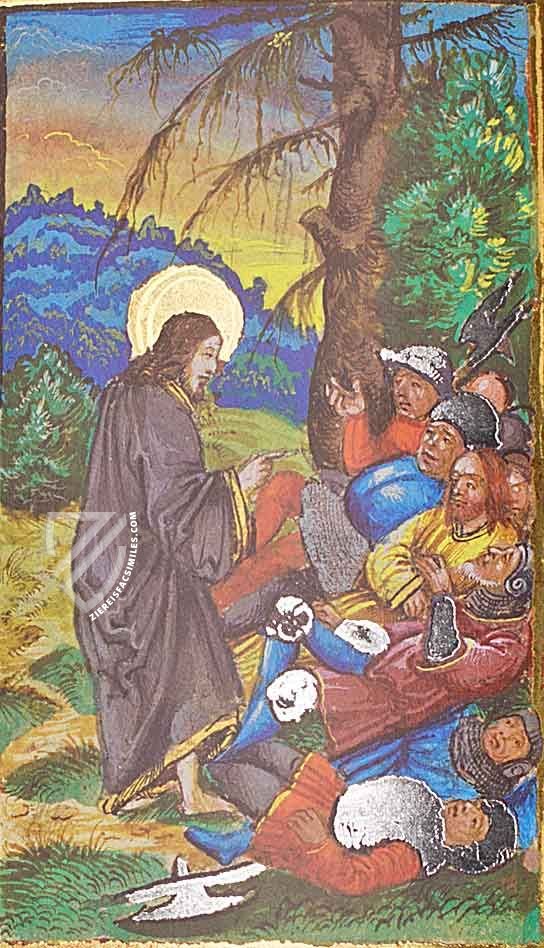
German Prayer Book of the Margravine of Brandenburg
Portrait while Deer Hunting
Susanna von Bayern (of Bavaria) was a vivacious and unique German noblewoman and niece of Emperor Maximilian I. Hunting was among the activities Susanna enjoyed, which are depicted throughout the manuscript in addition to the typical biblical scenes.
This hunting scene has a festive feel normally reserved for revelries and reflects the social importance hunts had among the aristocracy. The stag has been chased into a river by the hunting dogs while the hunters have formed on a bridge hoping to snatch it from the water. The detailed depiction of individual faces is quite impressive, and subtle pen strokes with gold ink highlight both the figures and the fauna in the scene. Susanna is likely the central figure wearing a yellow cloak.
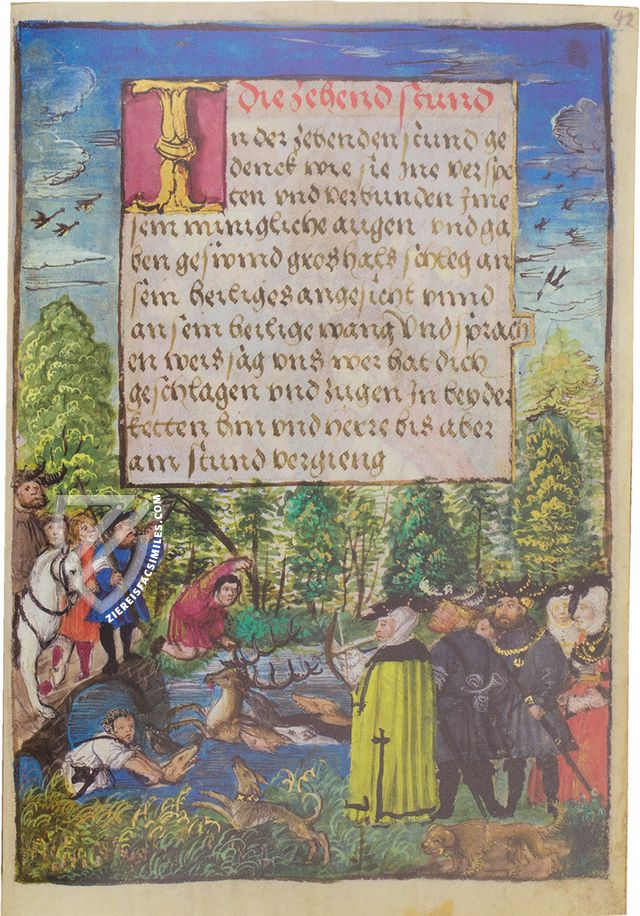
#1 Deutsches Gebetbuch der Markgräfin von Brandenburg
Languages: French, German
(1,000€ - 3,000€)
- Treatises / Secular Books
- Apocalypses / Beatus
- Astronomy / Astrology
- Bestiaries
- Bibles / Gospels
- Chronicles / History / Law
- Geography / Maps
- Saints' Lives
- Islam / Oriental
- Judaism / Hebrew
- Single Leaf Collections
- Leonardo da Vinci
- Literature / Poetry
- Liturgical Manuscripts
- Medicine / Botany / Alchemy
- Music
- Mythology / Prophecies
- Psalters
- Other Religious Books
- Games / Hunting
- Private Devotion Books
- Other Genres
- Afghanistan
- Armenia
- Austria
- Belgium
- Belize
- Bosnia and Herzegovina
- China
- Colombia
- Costa Rica
- Croatia
- Cyprus
- Czech Republic
- Denmark
- Egypt
- El Salvador
- Ethiopia
- France
- Germany
- Greece
- Guatemala
- Honduras
- Hungary
- India
- Iran
- Iraq
- Israel
- Italy
- Japan
- Jordan
- Kazakhstan
- Kyrgyzstan
- Lebanon
- Liechtenstein
- Luxembourg
- Mexico
- Morocco
- Netherlands
- Palestine
- Panama
- Peru
- Poland
- Portugal
- Romania
- Russia
- Serbia
- Spain
- Sri Lanka
- Sweden
- Switzerland
- Syria
- Tajikistan
- Turkey
- Turkmenistan
- Ukraine
- United Kingdom
- United States
- Uzbekistan
- Vatican City
- A. Oosthoek, van Holkema & Warendorf
- Aboca Museum
- Ajuntament de Valencia
- Akademie Verlag
- Akademische Druck- u. Verlagsanstalt (ADEVA)
- Aldo Ausilio Editore - Bottega d’Erasmo
- Alecto Historical Editions
- Alkuin Verlag
- Almqvist & Wiksell
- Amilcare Pizzi
- Andreas & Andreas Verlagsbuchhandlung
- Archa 90
- Archiv Verlag
- Archivi Edizioni
- Arnold Verlag
- ARS
- Ars Magna
- ArtCodex
- AyN Ediciones
- Azimuth Editions
- Badenia Verlag
- Bärenreiter-Verlag
- Belser Verlag
- Belser Verlag / WK Wertkontor
- Benziger Verlag
- Bernardinum Wydawnictwo
- BiblioGemma
- Biblioteca Apostolica Vaticana (Vaticanstadt, Vaticanstadt)
- Bibliotheca Palatina Faksimile Verlag
- Bibliotheca Rara
- Boydell & Brewer
- Bramante Edizioni
- Bredius Genootschap
- Brepols Publishers
- British Library
- C. Weckesser
- Caixa Catalunya
- Canesi
- CAPSA, Ars Scriptoria
- Caratzas Brothers, Publishers
- Carus Verlag
- Casamassima Libri
- Centrum Cartographie Verlag GmbH
- Chavane Verlag
- Christian Brandstätter Verlag
- Circulo Cientifico
- Club Bibliófilo Versol
- Club du Livre
- CM Editores
- Collegium Graphicum
- Collezione Apocrifa Da Vinci
- Comissão Nacional para as Comemorações dos Descobrimentos Portugueses
- Coron Verlag
- Corvina
- CTHS
- D. S. Brewer
- Damon
- De Agostini/UTET
- De Nederlandsche Boekhandel
- De Schutter
- Deuschle & Stemmle
- Deutscher Verlag für Kunstwissenschaft
- DIAMM
- Droz
- E. Schreiber Graphische Kunstanstalten
- Ediciones Boreal
- Ediciones Grial
- Ediclube
- Edições Inapa
- Edilan
- Editalia
- Edition Deuschle
- Edition Georg Popp
- Edition Leipzig
- Edition Libri Illustri
- Editiones Reales Sitios S. L.
- Éditions de l'Oiseau Lyre
- Editions Medicina Rara
- Editorial Casariego
- Editorial Mintzoa
- Editrice Antenore
- Editrice Velar
- Edizioni Edison
- Egeria, S.L.
- Eikon Editores
- Electa
- Emery Walker Limited
- Enciclopèdia Catalana
- Eos-Verlag
- Ephesus Publishing
- Ernst Battenberg
- Eugrammia Press
- Extraordinary Editions
- Fackelverlag
- Facsimila Art & Edition
- Facsimile Editions Ltd.
- Facsimilia Art & Edition Ebert KG
- Faksimile Verlag
- Feuermann Verlag
- Folger Shakespeare Library
- Franco Cosimo Panini Editore
- Friedrich Wittig Verlag
- Fundación Hullera Vasco-Leonesa
- G. Braziller
- Gabriele Mazzotta Editore
- Gebr. Mann Verlag
- Gesellschaft für graphische Industrie
- Getty Research Institute
- Giovanni Domenico de Rossi
- Giunti Editore
- Graffiti
- Grafica European Center of Fine Arts
- Guido Pressler
- Guillermo Blazquez
- Gustav Kiepenheuer
- H. N. Abrams
- Harrassowitz
- Harvard University Press
- Helikon
- Hendrickson Publishers
- Henning Oppermann
- Herder Verlag
- Hes & De Graaf Publishers
- Hoepli
- Holbein-Verlag
- Houghton Library
- Hugo Schmidt Verlag
- Idion Verlag
- Il Bulino, edizioni d'arte
- ILte
- Imago
- Insel Verlag
- Insel-Verlag Anton Kippenberger
- Instituto de Estudios Altoaragoneses
- Instituto Nacional de Antropología e Historia
- Introligatornia Budnik Jerzy
- Istituto dell'Enciclopedia Italiana - Treccani
- Istituto Ellenico di Studi Bizantini e Postbizantini
- Istituto Geografico De Agostini
- Istituto Poligrafico e Zecca dello Stato
- Italarte Art Establishments
- Jan Thorbecke Verlag
- Johnson Reprint Corporation
- Josef Stocker
- Josef Stocker-Schmid
- Jugoslavija
- Karl W. Hiersemann
- Kasper Straube
- Kaydeda Ediciones
- Kindler Verlag / Coron Verlag
- Kodansha International Ltd.
- Konrad Kölbl Verlag
- Kurt Wolff Verlag
- La Liberia dello Stato
- La Linea Editrice
- La Meta Editore
- Lambert Schneider
- Landeskreditbank Baden-Württemberg
- Leo S. Olschki
- Les Incunables
- Liber Artis
- Library of Congress
- Libreria Musicale Italiana
- Lichtdruck
- Lito Immagine Editore
- Lumen Artis
- Lund Humphries
- M. Moleiro Editor
- Maison des Sciences de l'homme et de la société de Poitiers
- Manuscriptum
- Martinus Nijhoff
- Maruzen-Yushodo Co. Ltd.
- MASA
- Massada Publishers
- McGraw-Hill
- Metropolitan Museum of Art
- Militos
- Millennium Liber
- Müller & Schindler
- Nahar - Stavit
- Nahar and Steimatzky
- National Library of Wales
- Neri Pozza
- Nova Charta
- Oceanum Verlag
- Odeon
- Orbis Mediaevalis
- Orbis Pictus
- Österreichische Staatsdruckerei
- Oxford University Press
- Pageant Books
- Parzellers Buchverlag
- Patrimonio Ediciones
- Pattloch Verlag
- PIAF
- Pieper Verlag
- Plon-Nourrit et cie
- Poligrafiche Bolis
- Presses Universitaires de Strasbourg
- Prestel Verlag
- Princeton University Press
- Prisma Verlag
- Priuli & Verlucca, editori
- Pro Sport Verlag
- Propyläen Verlag
- Pytheas Books
- Quaternio Verlag Luzern
- Reales Sitios
- Recht-Verlag
- Reichert Verlag
- Reichsdruckerei
- Reprint Verlag
- Riehn & Reusch
- Roberto Vattori Editore
- Rosenkilde and Bagger
- Roxburghe Club
- Salerno Editrice
- Saltellus Press
- Sandoz
- Sarajevo Svjetlost
- Schöck ArtPrint Kft.
- Schulsinger Brothers
- Scolar Press
- Scrinium
- Scripta Maneant
- Scriptorium
- Shazar
- Siloé, arte y bibliofilia
- SISMEL - Edizioni del Galluzzo
- Sociedad Mexicana de Antropología
- Société des Bibliophiles & Iconophiles de Belgique
- Soncin Publishing
- Sorli Ediciones
- Stainer and Bell
- Studer
- Styria Verlag
- Sumptibus Pragopress
- Szegedi Tudomànyegyetem
- Taberna Libraria
- Tarshish Books
- Taschen
- Tempus Libri
- Testimonio Compañía Editorial
- Thames and Hudson
- The Clear Vue Publishing Partnership Limited
- The Facsimile Codex
- The Folio Society
- The Marquess of Normanby
- The Richard III and Yorkist History Trust
- Tip.Le.Co
- TouchArt
- TREC Publishing House
- TRI Publishing Co.
- Trident Editore
- Tuliba Collection
- Typis Regiae Officinae Polygraphicae
- Union Verlag Berlin
- Universidad de Granada
- University of California Press
- University of Chicago Press
- Urs Graf
- Vallecchi
- Van Wijnen
- VCH, Acta Humaniora
- VDI Verlag
- VEB Deutscher Verlag für Musik
- Verlag Anton Pustet / Andreas Verlag
- Verlag Bibliophile Drucke Josef Stocker
- Verlag der Münchner Drucke
- Verlag für Regionalgeschichte
- Verlag Styria
- Vicent Garcia Editores
- W. Turnowski Ltd.
- W. Turnowsky
- Waanders Printers
- Wiener Mechitharisten-Congregation (Wien, Österreich)
- Wissenschaftliche Buchgesellschaft
- Wissenschaftliche Verlagsgesellschaft
- Wydawnictwo Dolnoslaskie
- Xuntanza Editorial
- Zakład Narodowy
- Zollikofer AG

